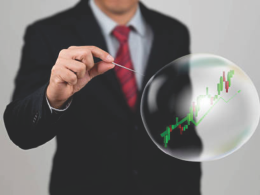by Jurrien Timmer, Director of Global Macro, Fidelity Investments
Golden colors
When you look at the scene above, do you see beautiful golden colors symbolling the afterglow of a warm summer and abundant harvest, or do you see the final glimpse of light and color before the inevitable onset of winter? It’s all a matter of perspective and acceptance, which is what’s on my mind this week as I am back in Holland to care for my parents. My 91-year old mom is back in the hospital with an unknown recovery ahead, while my dad just turned 98 yesterday. It’s a paradox of concurrent concern and celebration.
For now, my siblings and I (who are rotating in and out of The Hague) are hoping that our parents will be able to eventually settle back into their routine, while we contemplate our options if that’s no longer possible. We won’t know for a number of weeks, so for now it’s all hands on deck. But at 91 and 98, perhaps these are luxury problems after a long and bountiful harvest.
Perspective is as good a metaphor as any when we consider the price action of the past few weeks in the context of a most extraordinary several years in the markets, dominated by the ebb and flow of inflation and interest rates, geopolitics, and a winner-take-all AI boom sweeping the world. Did a bubble just burst, or has it not even started yet? Is the AI phenomenon the life-changing productivity-enhancing miracle that we all hope it will be (and that the world needs it to be in order stay ahead of an unsustainable debt burden), or is it just an exercise in circularity, in which the sellers of the picks and shovels finance the customers who are building the infrastructure in the hope that “if you build it they will come.”
The thing about markets is that we never know the answers in real time, and that is especially the case when the valuations are as high as the expectations. Which is why we look at charts. My conclusion remains that we are in a maturing bull market that is well short of a bubble, especially after the correction of the last few weeks. If there’s a choice between shaking the tree of weakhanded longs now, and dealing with the aftermath of an imploding bubble later, I will take the former any day.
The state of the cycle
And just like that. The stock market is down 5% from its recent all-time high. Drawdowns of that magnitude are a dime a dozen, of course, but still, even a 5% decline feels jarring after the relentless string of new all-time highs. As of Friday, 32% of the world’s stocks are above their 50-day moving average, which is well short of an oversold extreme.

Momentum no more
The air has suddenly been taken out of the speculative highfliers, such as the meme stocks, bitcoin sensitive stocks, SPACS, recent IPO’s, non-profitable tech, etc. I would argue this is probably a good thing.

Shaking the tree of excesses
Using Bloomberg EPS estimates, we can see that many of the extreme valuation readings from weeks ago have come in a bit better now (although still high). For instance, meme stocks have lost some 60 P/E points, while the big players (Mag 7) trade at 32.6x and the S&P 493 at 20.7x. For the large caps these are not bubble valuations.

In fact, NVDA as the poster child of the AI boom now sports a forward P/E of only 26x, which is very far from where CSCO traded in 1999 or 2000.

Sentiment
As one would expect, sentiment levels have come down quite a bit, and the call/put ratio is now below its average (1.25x).

Equal vs cap-weighted
While the cap-weighted S&P 500 index remains well supported by its rising trendline (blue), the equal-weighted S&P 500 has now fallen below its February high (which preceded the tariff tantrum). This tells me that the weakness is not just in the highflying momentum stocks or the Mag 7, but a broader based correction.

The road to new highs can be choppy
Whether the drawdown ends at 5% or goes to 10-15% or more is anyone’s guess of course, but it’s worth remembering that drawdowns are par for the course, especially when investors are attempting to put a multiple on a hard-to-quantify AI narrative. Case in point, the 1998-2000 analog shows that while the NASDAQ went parabolic in 1999, the S&P 500 made only modest gains in that final year (if you can call 20% gains modest), and did so in very choppy fashion riddled with multiple 10% corrections. Something to keep in mind as the market grapples with the AI narrative today.

Bonds are doing their job
With equities down 5%, it’s nice to see that bonds are fulfilling their as a source of balance for now. The stocks-bonds correlation, which was sharply negative 6 years ago and turned sharply positive 5 years ago, has been modestly positive for some time now.

We have an ever-so-slight negative divergence from high yield spreads at the recent high (meaning a higher high for stock prices and higher low for credit spreads), but so far, the spread widening in credit does not seem alarming at all. This suggests that the current drawdown in the momentum trade is just that, a drawdown.

Capex vs buybacks
One question to ponder is whether all this AI Capex will come at the expense of share buybacks. If so, that could suppress valuations for the big growers in the S&P 500. Currently the payout ratio (dividends + buybacks) in the S&P 500 is 75%, which is on par with the MSCI EAFE index. More on this next week.

This information is provided for educational purposes only and is not a recommendation or an offer or solicitation to buy or sell any security or for any investment advisory service. The views expressed are as of the date indicated, based on the information available at that time, and may change based on market or other conditions. Opinions discussed are those of the individual contributor, are subject to change, and do not necessarily represent the views of Fidelity. Fidelity does not assume any duty to update any of the information.
Copyright © Fidelity Investments














